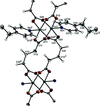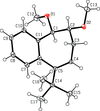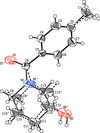issue contents
October 2017 issue

Cover illustration: The molecular structure of [Ti2Cl2(C6H18NSi2)4] shows a binuclear motif of TiIII atoms, formulated as [Ti(![[mu]](/logos/entities/mu_rmgif.gif) -Cl)(N(SiMe3)2)2]2, with two
-Cl)(N(SiMe3)2)2]2, with two ![[mu]](/logos/entities/mu_rmgif.gif) -Cl atoms bridging two ((Me3Si)2N)2Ti moieties. The coordination environment of both central TiIII atoms is distorted tetrahedral, with a nearly planar four-membered Ti2Cl2 core [Ti-Cl-Ti-Cl = 2.796 (15)°]. See: Quadri, Törnroos & Le Roux [IUCrData (2017). 2, x171488].
-Cl atoms bridging two ((Me3Si)2N)2Ti moieties. The coordination environment of both central TiIII atoms is distorted tetrahedral, with a nearly planar four-membered Ti2Cl2 core [Ti-Cl-Ti-Cl = 2.796 (15)°]. See: Quadri, Törnroos & Le Roux [IUCrData (2017). 2, x171488].
metal-organic compounds
Download citation


Download citation


Open  access
access
 access
accessThe molecular structure of the title compound, [FePt(CN)4(C14H8N2)2(H2O)2]n, consists of one-dimensional polymeric [–Fe–NC–Pt(CN)2–CN–]∞ chains. Two water molecules and two monodentate 1,4-bis(pyridin-4-yl)buta-1,3-diyne (bpb) ligand molecules complete the octahedral coordination sphere of the FeII atoms. The water molecules are hydrogen bonded to either bpb ligands or cyanide groups of the planar [Pt(CN)4]2− anion of adjacent polymeric chains.
CCDC reference: 1577444
Download citation


Download citation


Open  access
access
 access
accessIn the title compound, iridium adopts a distorted square-planar geometry and is coordinated to cyclooctadiene, a triphenyl phosphane, and a N-heterocyclic carbene ligands in the cationic complex with tetrafluoridoborate as the counter-anion.
CCDC reference: 1577406
Download citation


Download citation


Open  access
access
 access
accessIn the title linear polymeric structure, the Sn atom is five-coordinated by three methyl C atoms and two methylphenylphosphinate O atoms in a distorted trigonal–bipyramidal geometry.
CCDC reference: 1578530
Download citation


Download citation


Open  access
access
 access
accessGlutarate ligands bridge dinuclear Cu2 units to form one-dimensional chains and 1,4-bis(pyridin-4-yl)butane ligands connect these chains to form a two-dimensional layer structure. Carboxylates of a glutarate ligand bridge two copper(II) ions, forming a paddle-wheel-type Cu2(CO2)4 dinuclear secondary building unit.
CCDC reference: 1578612
Download citation


Download citation


Open  access
access
 access
accessIn the polymeric chain structure of the title compound, {(Me3Sn)[C6H3F2(SeOO)]}n, the SnIV atom adopts a distorted trigonal–bipyramidal coordination environment.
CCDC reference: 1578937
Download citation


Download citation


Open  access
access
 access
accessThe two TiIII atoms in the binuclear title compound are each tetrahedrally coordinated by two bridging Cl atoms and two N atoms of (trimethylsilyl)amido moieties.
CCDC reference: 1579885
organic compounds
Download citation


Download citation


Open  access
access
 access
accessAcetylhydroxamic acid can exist in two tautomeric forms, i.e. amide and imide. Each of these forms may be in the form of the Z or E isomer. The title compound is formed by the reaction of acetamide and hydroxylamine hydrochloride. In the crystal, molecules are connected by N—H⋯O and O—H⋯O hydrogen bonds, forming in chains in the c-axis direction.
CCDC reference: 1576592
Download citation


Download citation


Open  access
access
 access
accessIn the title compound, C10H17NO3, the five-membered ring is in a slightly twisted envelope conformation. In the crystal, molecules are linked via N—H⋯O hydrogen bonds forming C(4) chains along [001].
CCDC reference: 1577698
Download citation


Download citation


Open  access
access
 access
accessIn the title compound, C15H27NO4, the cyclopentane ring adopts an envelope conformation with the methylene group as the flap. The dihedral angle between the cyclopropane and cyclopentane rings is 77.54 (13)°. In the crystal, molecules are linked via O—H⋯O hydrogen bonds, forming C(7) chains propagating along [010].
CCDC reference: 1577701
Download citation


Download citation


Open  access
access
 access
accessThe relative stereochemistry of the title compound, C17H24O2, has been confirmed by the X-ray analysis. The seven-membered ring is in a pseudo-boat conformation with both methoxy substituents in equatorial sites.
CCDC reference: 1577694
Download citation


Download citation


Open  access
access
 access
accessThe crystal structure of a dibromohydrazonomethylphenol, prepared from dibromohydroxybenzaldehyde and hydrazine hydrate, is reported.
CCDC reference: 1576511
Download citation


Download citation


Open  access
access
 access
accessIn the title compound, the dihedral angle between the planes of the benzene and pyridine rings is 55.30 (13)°. In the crystal, molecules are linked by O—H⋯O and C—H⋯O hydrogen bonds, forming a three-dimensional framework.
CCDC reference: 1575441
Download citation


Download citation


Open  access
access
 access
accessThe pyrazolopyrimidine unit is slightly twisted while π-stacking interactions between pyrimidine moieties form centrosymmetric dimers. Offset π-stacking interactions between dimers form chains along the b-axis direction.
CCDC reference: 1576254
Download citation


Download citation


Open  access
access
 access
accessThe dihydroquinoxaline moiety deviates from planarity with a dihedral angle of 1.52 (16)° between the constituent rings. In the crystal, zigzag chains are generated by N—H⋯N and N—H⋯Cl hydrogen bonds and are extended into sheets parallel to (100) by N—H⋯O hydrogen bonds.
CCDC reference: 1577756
Download citation


Download citation


Open  access
access
 access
accessThe title compound crystallizes with two molecules in the asymmetric unit, one of which features a disordered ethyl side chain.
CCDC reference: 1578486
Download citation


Download citation


Open  access
access
 access
accessIn the hydrated cocrystal of cis-1,3-cyclohexanedicarboxylic acid (H2cdc) and N,N′-(pentane-1,5-diyl)bis(pyridine-4-carboxamide)pentane (bpcpe), O—H⋯N hydrogen bonding interactions produce supramolecular chains.
CCDC reference: 1579775
Download citation


Download citation


Open  access
access
 access
accessThe molecular structure of the title imidazole derivative is reported.
CCDC reference: 1579590
Download citation


Download citation


Open  access
access
 access
accessThe molecular structure of N,N,N-tris(diphenylphosphorylmethyl)amine exhibits threefold symmetry which is not reflected in the solid state structure.
CCDC reference: 1579667
Download citation


Download citation


Open  access
access
 access
accessIn the crystal of the hybrid imine/urea molecule, N—H⋯O hydrogen bonds link molecules into supramolecular helical chains parallel to the c axis via an  (6) ring motif.
(6) ring motif.
CCDC reference: 1580619
Download citation


Download citation


Open  access
access
 access
accessThe asymmetric unit of the title compound contains two independent molecules differing in the orientation of the propargyl side chain.
CCDC reference: 1581006
Download citation


Download citation


Open  access
access
 access
accessThe title compound features dimers linked by four C—H⋯O hydrogen bonds.
CCDC reference: 1581123
Download citation


Download citation


Open  access
access
 access
accessIn the title molecule,the piperidine ring assumes a chair conformation. The dihedral angle between the mean plane of the piperidine ring and the benzene ring is 45.49 (1)°. In the crystal, molecules are linked by O—H⋯O hydrogen bonds, leading to a molecular chain running along the c-axis direction.
CCDC reference: 1580031
Download citation


Download citation


Open  access
access
 access
accessThe title compound, which crystallizes with two molecules in the asymmetric unit, was obtained in the course of the total synthesis of curvicollides A–C and fusaequisin A. It features the relative configuration of the western aldol part of the natural products. In the crystal, molecules are linked by C—H⋯O hydrogen bonds.
CCDC reference: 1581433
Download citation


Download citation


Open  access
access
 access
accessThe structure of the title imidazolidinedione derivative is reported. The crystal packing is stabilized by N—H⋯O and C—H⋯π(ring) hydrogen bonds.
CCDC reference: 1581286
Download citation


Download citation


Open  access
access
 access
accessThe title compound is a condensation product of 3-amino-2-chloropyridine and ethyl 2-aminobenzoate in which the aromatic rings are almost coplanar [dihedral angle = 2.28 (9)°] and an intramolecular N—H⋯O hydrogen bond occurs. In the crystal, N—H⋯O and N—H⋯N hydrogen bonds link the molecules into (100) sheets.
CCDC reference: 1024196
Download citation


Download citation


Open  access
access
 access
accessThis compound was prepared by bromination/dehydrobromination of E,E,Z-cyclododecatriene. The crystal is composed of C2-symmetrical molecules with an E conformation of the bromoalkene fragments and nearly linear alkyne units. The torsion angles in the ring suggest significant ring strain.
CCDC reference: 1581763
Download citation


Download citation


Open  access
access
 access
accessIn the title compound, the mean plane of the thiazole ring subtends dihedral angles of 3.6 (2) and 79.9 (2)° with the bromobenzyl and toluyl rings, respectively. In the crystal, short S⋯O contacts [3.012 (3) Å] and aromatic π–π stacking between the thiazole and toluyl rings [centroid–centroid separation = 3.687 (2) Å] are observed.
CCDC reference: 1543222
Download citation


Download citation


Open  access
access
 access
accessThe molecular and crystal structures of a tryptophane derivative are reported. The packing features N—H⋯O hydrogen bonds and N—H⋯π and C—H⋯π interactions.
CCDC reference: 1573006


 journal menu
journal menu







































![[publCIF]](/logos/authorchecklist11.gif)





